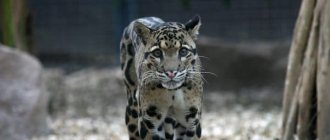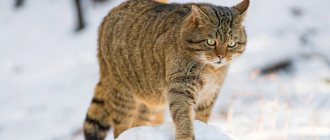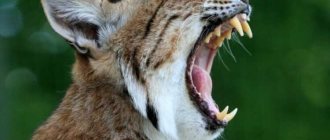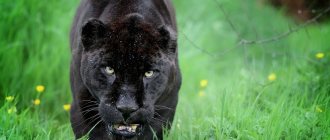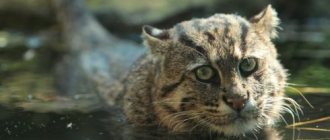The snow leopard or snow leopard is one of the most beautiful representatives of predators, which chose the mountains as its natural habitat. Habits, color - everything about this animal is beautiful, which, in fact, played a cruel joke. Humanity, for the purposes of fishing and profit, at one time almost completely exterminated this animal. At the moment, the snow leopard is included in the Red Book and is under strict protection.
Description
The length of the body of an adult is 1000-1300 mm, the length of the tail is about 800-1000 mm and is equal to approximately 75% to 90% of the total body length. This extremely long tail is used for balancing in the rocky and mountainous terrain where they live, and the animals also use it to keep their limbs warm during harsh winter weather. The average weight of an adult snow leopard is 35-45 kg. There is no pronounced sexual dimorphism among these animals, but males may slightly exceed females in weight. Compared to other felines, snow leopards have slightly larger front paws, with an average foot pad measuring 90 to 100 mm in length and 70 to 80 mm in width. They also have relatively long hind legs, adapted for better maneuvering and jumping in their habitat.
The fur color of the snow leopard varies from light gray to smoky gray, with a creamy yellow and white tint usually found on the belly. The entire body of the snow leopard is covered with gray-black spots, which are surrounded by black rings. Larger spots and rings surrounding them are found only on the body and tail, while solid spots are common on the head, neck and lower limbs. Juveniles have longitudinal black stripes running along the back from head to tail. As they grow and mature, these stripes break up into large spots that form lateral rows of elongated rings along the center of the back.
Snow leopards have long, thick fur that sheds twice a year. In winter it becomes thicker and longer. In summer, the length of the snow leopard's fur is about 25 mm on the sides and approximately 50 mm on the belly and tail. In winter, the fur reaches 50 mm on the sides, from 30 to 55 mm on the back, 60 mm on the tail and up to 120 mm on the belly. In addition to their thick fur, they have small, rounded ears that help minimize heat loss in cold conditions. Compared to other felines, snow leopards have much larger nasal cavities, as well as small and wide heads in relation to their body size.
Snow leopard: description
The animal, which lives high in the mountains of Central Asia, is also called the snow leopard or snow leopard. The name snow leopard comes from Turkic hunters, and was borrowed by Russian merchants back in the 17th century. Only 100 years later did Europeans learn about the existence of this beast. This happened in 1761, when Georges Buffon presented a drawing of this animal with a note that the snow leopard was trained in order to participate in the hunt. It was also indicated here that the animal is found in Persia.
In 1775, a scientific description of the snow leopard was published, presented by the scientist naturalist Johann Schreber. After this, for many centuries, the snow leopard was studied by many zoologists and travelers, including Nikolai Przhevalsky. According to some paleogeneticists, this animal belongs to an ancient species that appeared on planet Earth almost one and a half million years ago.
Appearance
The snow leopard is an impressively sized cat, somewhat reminiscent of a leopard, but not as large in size and more squat. There are a number of other signs that allow you to distinguish a leopard from a leopard: the snow leopard’s tail reaches ¾ of the body length, and the coat is dotted with patterns in the form of rosettes and spots. Adult snow leopards grow up to 2 and a half meters in length, including their tail. The height of the predator at the withers reaches 60 centimeters. Males are heavier, about 55 kg, compared to females, whose weight is no more than 40 kilograms. The head of this animal is round and not large, with the same round and short ears. There are no tufts on the ears, like lynxes, and in winter, due to the thick fur, the ears are practically invisible.
The predator has quite expressive eyes, the color of which matches the color of the fur and whiskers, up to 10 cm long. The legs of the snow leopard are relatively short, and the paws are wide and massive, armed with retractable claws. The tracks left by this predator are round in shape and without claw marks. The tail looks somewhat thicker than it actually is due to the high and thick fur. Thanks to its long tail, the predator can easily maintain its balance while moving in such difficult mountain conditions.
Interesting to know! Snow leopard fur is incredibly thick and soft to the touch. Thanks to this quality of wool, the animal manages to survive in such harsh conditions. The density of the coat is the same as that of ordinary cats, which is considered very unique.
The color of the coat in the back area, as well as the upper areas of the sides, is distinguished by a light gray shade, turning more into white, while the color of the belly and thick parts of the limbs, as well as the lower areas of the sides, is lighter. The unique pattern consists of large round rosettes, as well as solid spots, also round, in black or dark gray. The smallest spots are located on the head of the predator, and larger ones adorn the neck and legs. Closer to the back of the back, the spots seem to merge and form peculiar stripes located along the back. The second half of the tail is characterized by the fact that the spots also merge and form a wide, incomplete ring, while the tip of the tail is always black.
The animal's winter coat has a grayish tint with a smoky touch, which is more typical on the back and sides. Sometimes there is a slight yellowish tint. Thanks to this body color, the snow leopard is easily camouflaged among snow, ice and rocks. With the arrival of summer, the snow leopard's fur color becomes almost white, so the dark spots become more noticeable.
Adult individuals, and especially older ones, do not have such bright fur as their younger relatives.
Behavior and lifestyle
This is an animal that is tied to territory and prefers to lead a solitary lifestyle. Groups of animals can only be seen when females are engaged in feeding and raising their offspring. Each adult individual has its own section of territory, ranging from 15 to 200 square km. The border of each individual is marked with a special secret, although snow leopards do not try to defend it in fights. The snow leopard goes hunting either early in the morning or at dusk and rarely during the daytime. These animals, living in the Himalayas, hunt exclusively in twilight conditions.
During the daytime, the cat rests on the rocks, and it can use the same den for many years. For a den, the snow leopard looks for suitable places, using rock crevices or caves, as well as rocky placers, preferring places located under overhanging stone slabs. There is evidence that some hunters have seen snow leopards in the Kyrgyz Alatau, which have chosen the nests of black vultures.
Interesting moment! The animal regularly walks around its territory, appearing in pastures or camps of wild ungulates, while adhering to the same route. As a rule, the snow leopard trail runs along a mountain ridge or along a river or mountain stream.
Since the territory controlled by the predator is quite large, it takes several days to walk around it. Therefore, a snow leopard appears at one point quite rarely. In addition, due to deep and loose snow, the animal cannot move quickly. Because of this, the snow leopard always prefers to stick to the same route.
SNOW LEOPARD IRBIS - INTERESTING FACTS
How long do snow leopards live?
Living in natural conditions, the snow leopard lives on average about 13 years. If an animal is kept in artificial conditions, then its life expectancy is almost 2 times longer. In zoological parks, snow leopards live for about 21 years, although there is a known case where a female snow leopard lived in captivity for 28 years.
Natural habitats
The habitat of the snow leopard extends exclusively to the mountainous regions of Central and South Asia, the area of which is about 1.23 million square kilometers. Therefore, the snow leopard can be found in the following countries:
- In Russia and Mongolia.
- In Kyrgyzstan and Kazakhstan.
- In Uzbekistan and Tajikistan.
- In Pakistan and Nepal.
- In China and Afghanistan.
- In India, Myanmar and Bhutan.
If you look at the geographical distribution of the habitats of this predator, then the habitat begins in the east of Afghanistan, as well as within the Syr Darya and passes through the Altai, Tannu-Ola, Sayan Mountains, crossing the Pamirs, Tien Shan, Himalayas, Kashmir, etc. In Tibet, the snow leopard lives up to the northern borders of Altushan, and in Mongolia - within the Mongolian-Gobi Altai.
Important fact! Russia is home to no more than 3 percent of the total number of these predators, which are distributed over an area of about 60 thousand square kilometers. The snow leopard in Russia represents the northern and northwestern boundaries of the snow leopard's habitat.
The snow leopard prefers high mountains and eternal snow, choosing to live in areas located on open plateaus, on gentle or steep slopes, as well as in small valleys covered with alpine vegetation, as well as with piles of stones and rocky gorges. Often the snow leopard can be found on flatter areas, with bushes and rocky terrain, where the predator can hide without problems. These animals are more common on the border located above forested areas, although from time to time they also appear in forested areas, especially in winter.
What does it eat?
The snow leopard can attack prey that is three times heavier than itself and easily deals with it. In the wild, this predator hunts the following ungulates:
- On horned and Siberian mountain goats.
- For argali.
- On blue rams.
- For takins and tara.
- On argali and gorals.
- For musk deer and deer.
- For serow and roe deer.
- For wild boars and deer.
With a shortage of wild ungulates, the snow leopard begins to hunt smaller animals such as ground squirrels and pikas, as well as birds such as pheasants, snowcocks and chukars. If necessary, this predator can easily cope with a brown bear, and can also hunt domestic animals such as goats, sheep, horses, etc.
Interesting to know! An adult animal can eat up to 3 kg of meat at one time. With the onset of summer, the predator begins to consume various grasses or young shoots. A predator needs fresh greens to improve the functioning of the digestive system; moreover, this is how predators replenish their bodies with vitamins and minerals.
As a rule, this animal prefers to hunt alone, hiding not far from watering places, salt licks and trails. The snow leopard pounces on its prey from above, from the rocks, or quietly creeps as close as possible.
Closer to autumn, and also with the onset of winter, the female goes hunting with her offspring. The predator attacks its potential prey from a distance of several jumps. If the attack is unsuccessful and the victim manages to escape, the snow leopard never pursues it for more than 3 hundred meters.
As a rule, the snow leopard grabs the animal by the throat, after which it strangles and breaks the neck. After this, he drags the animal’s carcass to a safe shelter where he can eat in peace. Having eaten, the predator can abandon the prey, or it can stay next to it, driving away everyone who wants to dine in the same way.
Reproduction and offspring
It is very difficult to study the life activities of the snow leopard in natural conditions. The fact is that the density of these predators is quite low, and, moreover, the living conditions of these animals do not allow them to fully monitor their life cycles. In this regard, even today researchers do not have all the information about these animals, including some aspects of their reproductive capabilities. The breeding season for predators begins with the arrival of spring. During this period, the males begin to make some sounds that resemble a loud bass meow.
The female does not mate every year, but approximately once every 2 years. Pregnancy lasts from 3 to 4 months. The female sets up her den in the most inaccessible places. After mating, the male leaves the female, entrusting all the care of feeding and raising the future offspring to her. Offspring appear in April/May/June, depending on natural conditions.
Important fact! As a rule, a female gives birth to no more than 3 kittens, although there is information that there can be up to 7 cubs in a litter, although this happens quite rarely. The kittens that are born are blind, helpless, and their body is covered with thick fur, brownish in color, with solid spots, dark in color. The length of newborns can be up to 30 cm, with a weight of about 0.5 kilograms. After about a week or a little more, their eyes open and they begin to see. However, only after a couple of months they begin to leave the den, crawling out. From this moment on, meat begins to appear in their diet, and not just milk.
After a month, the kittens follow their mother completely independently, and already at six months they take part in the hunt. From this period, the juveniles begin to learn the basics of hunting, so they all watch for the prey together, but the decisive throw remains with the mother. The offspring will be fully independent only a year later, next spring. Individuals become sexually mature no earlier than after 3 or 4 years of life.
Natural enemies
The snow leopard has no natural enemies other than humans, since this predator lives in places inaccessible to other predators. In addition, the snow leopard has no competitors and is at the top of the food pyramid. Thanks to such isolation, the animal is protected from incredible enemies, including humans.
Area
Snow leopards live over large areas of approximately 2.3 million square kilometers. They can be found on all the high mountain ranges of Central Asia. This includes the entire Himalayan mountain system, as well as areas in Bhutan, Nepal and Siberia of Russia. Snow leopards are found anywhere from the Himalayas to southern and western Mongolia and southern Russia, but 60% of the population is found in China, especially in the autonomous regions of Xinjiang and Tebet, and in the provinces of Sichuan, Qinghai and Gansu.
Snow leopard breeding
The mating season for snow leopards begins at the end of winter and continues until the beginning of spring.
During this period, females set up a den in hard-to-reach places. The duration of pregnancy ranges from 90 to 110 days; births occur in adult females on average once every 2 years. Babies are born blind and helpless in April-June. There are 2-3 of them in one litter, sometimes 4-5. The weight of newborns is about 0.5 kg, the body is up to 30 cm long. After a week, their eyes open. For the first six months of life, babies are breastfed, but already at the age of 1.5 months they also eat meat supplements. Males do not take part in raising the young. The female mother teaches her offspring how to hunt and so on. The lifespan of snow leopards in natural conditions is 10-13 years.
Habitat
Steep, rocky, and rugged terrain is the preferred resting place for snow leopards, particularly near natural vegetation. The cliffs and large ridges are ideal for daytime recreation. Snow leopards live in alpine and subalpine zones at altitudes from 900 to 5,500 meters and above, but most often at altitudes between 3,000 and 4,500 meters. In winter they can migrate to lower places, to an altitude of 900 meters. Snow leopards generally avoid dense forests and cultivated fields, but can inhabit coniferous forests, as well as arid and semi-arid scrubland, grasslands, mountain grasslands and barren areas.
In western Nepal, an area with high prey densities, the average habitat range size ranges from 12 to 39 square kilometers. However, in areas with difficult terrain, the actual range is likely to be 20-30% greater.
Reproduction
Snow leopards are solitary animals and do not communicate with others of their own kind unless it is mating season. Due to the long time spent raising their young, females mate every second year. They are polygamous in the wild, but some snow leopards have been known to become monogamous in captivity.
Snow leopard breeding is highly seasonal and occurs from January to March. When females come into heat, they make a continuous squeaking sound that attracts males. The female offers herself to the male - she raises her tail and walks around him. During mating, the male grabs the hair on the female's neck, thereby holding her in one position. Gestation lasts 90-105 days, with cubs born from April to June. The number of offspring per litter is 2-3 kittens, but in rare cases varies from 1 to 5. They are born in rocky shelters, where the female makes a warm nest of wool on her belly. At birth, snow leopard kittens weigh between 300 and 600 grams.
Breastfeeding lasts about 5 months, but young animals can consume solid food as early as 2 months of age. The first year of life there is a close connection between the mother and her offspring. Females reach sexual maturity at 2-3 years, and males at 4 years.
Since snow leopards are solitary animals, the longest social contact occurs during the period when females are raising their offspring. Kittens are born blind and open their eyes when they reach one week of age.
The reproductive rate of snow leopards is higher in areas where females have the opportunity to hide in reliable shelter and also feed on prey nearby. This is necessary for the safety of their offspring, since inaccessible and reliable shelter helps hide the babies from other predators and allows females to hunt freely. After reaching three months of age, kittens follow their mother and learn basic survival skills such as hunting. During the first year of life, the mother provides the cubs with food, protection, training and other necessary resources.
Population and species status
Based on data from the World Wildlife Fund, between 3 and a half and 7 and a half thousand of these animals currently live on planet Earth. About a couple thousand more live and breed in zoos. The decline in the population of these predators is associated with illegal hunting for the valuable fur of the animal. Therefore, the snow leopard is considered a small, rare animal that is in danger of complete extinction.
Important fact! Despite the fact that all countries where the snow leopard is found protect these animals at the legal level and hunting them is prohibited, poachers still hunt them. Since 1997, the snow leopard has been listed in the Red Book of Mongolia under the status of “very rare”, and in some countries – under the status of “endangered as a species”.
The snow leopard is also listed in Appendix I of the Convention on International Trade in Endangered Species of Flora and Fauna. Under the same wording, the snow leopard was included in the 2000 IUCN Red List. As a result of the work of environmental structures that monitor the dynamics of poaching of animal fur, it was found that the provisions for the protection of the species in almost all countries, although being implemented, are insufficient. In addition, none of the countries have adopted long-term programs that would allow the conservation of the snow leopard.
Snow leopard prince of the mountains Wildlife animals of the taiga of the Far East Red Book of rare species
Behavior
Snow leopards are most active during dawn and dusk. They are also very mobile and can move from one place to another every day and change their resting place several times during the day. Generally, they stay in one specific area for several weeks and then move to another.
Snow leopards are solitary animals, but during the mating season they are in pairs, so they share territory with each other. Individuals that are forced to share territory maintain a distance of approximately 2 km from the nearest individual. Snow leopards avoid each other by marking their paths with scratches, feces and special glands that can describe the sex and reproductive status of the individual.
They have a well-developed ability to jump high thanks to their wide paws and elongated hind legs. Snow leopards prefer to spend their time on tall structures, especially when living in captivity. A rare observation of the behavior of snow leopards in captivity has determined that the animals reduce their activity in places where people are present.
The preferred method of hunting is stalking. They then ambush their prey from higher ground, using rocky terrain and shrubby vegetation for camouflage.
How does the snow leopard hunt?
Snow leopards are famous predators. Moreover, they prefer to hunt even larger game than themselves, and most often do this from an ambush. Hiding on the rocks, the snow leopard alone patiently watches for potential prey near trails or watering holes. As soon as one appears within reach, the predator immediately rushes towards it and, after making several giant leaps, overtakes the prey. The snow leopard prefers to grab its prey by the throat. Most often, he immediately manages to strangle the animal or break its neck. The snow leopard first drags the already lifeless victim into shelter and only then begins to eat.
The leopard is the record holder for long jump among cats. In pursuit of prey, it can jump up to 6 m and 2.5-3 m in height. The long tail helps the animal maintain its balance.
Communication and perception
Unlike other large cats, snow leopards do not growl. Instead, they emit a high-pitched howl, especially females during the breeding season. This sound allows females to notify males of their location and, as a rule, this happens late in the evening. Vocalizations are non-aggressive and the sound is produced through the nostrils of the animals. The presence of one snow leopard in close proximity to another produces this sound, and can be described as a greeting.
Snow leopards make high-pitched sounds and communicate their location. Their long tails are used in a number of communication functions. Animals also use tactile communication, namely rubbing the head and neck of their social partner, which indicates a peaceful mood.
Another way of communication is facial expressions. For example, when defending, they open their jaws quite wide and lift their lips to expose their fangs. However, when they are friendly, they only open their mouth without exposing their fangs, and also wrinkle their nose.
Snow leopards, like other felines, prefer to communicate through scents and other chemicals.
Dimensions and appearance
The snow leopard is a large, graceful cat. Externally, the snow leopard is similar to a leopard, but differs in its stockier body, longer tail and fur. The length of the body including the head is approximately 1-1.4 meters, the length of the tail is about 0.9-1.1 meters, that is, the tail of the animal is more than 3/4 of the length of the body. The tail is covered with long hair, so it visually appears very thick. The thickness of the tail is almost equal to the circumference of the animal's forearm. The tail helps the predator maintain balance when jumping.
Males are larger than females. The average weight of a male is about 45-55 kg, the female weighs on average from 25 to 40 kg. The height of the animal at the withers is about 60 cm.
The paws are wide and massive, but short relative to the body. The snow leopard has retractable claws, so it leaves behind round tracks without claw marks. The head of the animal is small relative to the size of the body, round. Small rounded ears without tassels at the ends; in winter, due to the thick fur, they are practically invisible. The animal has long whiskers (whiskers), black or white, up to 10.5 cm long. The predator does not have a mane or sideburns.
The snow leopard has thick, soft fur. The length of the hair on the back reaches 55 cm. In terms of the thickness of its fur, the snow leopard resembles small cats, this distinguishes it from other big cats - lion, leopard, tiger, jaguar. The color is brownish-gray, without any admixtures of yellow or red. The fur on the back and upper sides is smoky. The fur on the belly, lower sides and inside of the paws is a lighter shade. The smoky shade is more pronounced in winter than in summer. Smoky gray fur with dark spots helps snow leopards remain undetected against the background of rocks, stones and snowdrifts.
Large ring-shaped dark spots in the form of rosettes are scattered throughout the skin. There are also smaller solid spots of dark gray or black. The spots on the head are smaller, those on the back and neck are larger. At the base of the back, the spots often merge with each other, forming longitudinal black stripes along the animal's spine. The tip of the tail is usually black.
Young snow leopards have more distinct spots. Females and males do not differ in color. Geographical variation in color is practically absent. This is mainly due to the small habitat of the animal.
Nutrition
Snow leopards are carnivores and actively hunt for their prey. They are also opportunistic predators and will consume any meat to provide their body with the energy it needs. Snow leopards are capable of killing animals 3-4 times their weight, but if necessary they can consume much smaller prey.
The main animal that snow leopards feed on is nakhur (Pseudois nayaur). Other prey species include Siberian ibex (Capra ibex sibrica), marking goat (Capra failconeri), argali (Ovis ammon), mouflon (Ovis orientalis), Himalayan tahr (Hemitragus jemlahicus), Sumatran serow (Capricornis sumatraensis), Himalayan goral (Naemorhaedus goral), red-bellied musk deer (Moschus chrysogaster), wild boar (Sus scrofa), orongo (Pantholops hodgsonf), Tibetan gazelle (Procapra picticaudata), goitered gazelle (Gazella subgutturosa) and wild ass (Equus hemionus). Small prey includes marmots (Marmota), hares (Lepus), pikas (Ochotona), gray voles (Microtus), mice and birds.
Due to overhunting by humans, the population of wild ungulates in certain regions has declined significantly, and snow leopards have begun to prey on livestock.
Threats
Snow leopards are predatory animals, so they have fewer threats from wild animals than from people. However, interspecific killing between leopards (Panthera pardus) and snow leopards can occur when competition for resources increases. Adults are also a potential threat to young animals.
In the last two decades, the population has declined by at least 20% due to habitat loss, prey, poaching and persecution. The main factor influencing population decline is human activity. Wool, bones and other body parts are of particular value to poachers. The skin is in great demand. Recently, their bones have become a popular substitute for tiger bones in Chinese medicine. Many farmers are responsible for killing snow leopards and risk losing their livestock.
Conservation of the species
Today, the territories where this predator lives are under strict protection. But, despite such events, there are still hunters and herders who kill animals just to get fur.
In addition, in its natural habitat, also with human help, quite a lot of threats have appeared for the animal. For example, environmental degradation in nature, which is caused by the development of the mining and extractive industries. In addition, the decrease in the number of species is extremely negatively affected by the decrease in food items.
According to statistics, in the period from 2002 to 2021 alone, the number of this animal in Russia has decreased by almost three times. However, there is also a positive thing - thanks to the implementation of some environmental protection projects, the population of the predator has recently begun to grow. Thus, the situation has improved significantly due to the opening of the Sailyugem National Park. The protected area is located in Altai.
The threat of extinction of the species is also due to the fact that due to negative circumstances (shooting, poor ecology, lack of food) the number of females has significantly decreased. At the moment, they live only in some areas, and therefore the reproduction of the species still remains under threat.
Role in the ecosystem
Snow leopards are apex predators, meaning they play a key role in maintaining biodiversity in the ecosystem. They are an important indicator of environmental health and help regulate animal populations lower on the food chain.
Snow leopards can be recognized as indicator species, and this is important because it provides an opportunity to motivate the public to support ecosystem conservation. If snow leopard habitats are protected, many other animals will also have their habitats protected.
Parasites that live off the snow leopard: heartworms, toxoplasma, roundworm, fleas, ticks, strongylids, nematodes, etc.
A little history of the species
Although these animals were originally thought to be the first species to diverge within the genus Panthera, they have recently been shown to form a sister clade to tigers. Some scientists believe that it is likely that these two groups separated from the rest of the Panthers between 4.6 and 1.8 million years ago, and then split among themselves about 3 million years ago. Given the fact that tigers have the same ability to roar as the rest of the genus Panthera, but snow leopards do not, it is possible that this feature was present in the common ancestor of Panthera, which has disappeared in snow leopards since they split from tigers.
